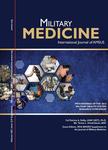版权所有:内蒙古大学图书馆 技术提供:维普资讯• 智图
内蒙古自治区呼和浩特市赛罕区大学西街235号 邮编: 010021

作者机构:US Army Thermal Mt Med Div Res Inst Environm Med 10 Gen Greene Ave Natick MA 01760 USA US Army Mil Nutr Div Res Inst Environm Med 10 Gen Greene Ave Natick MA 01760 USA DSO Labs Def Med & Environm Res Inst Human Performance Lab 12 Sci Pk Dr Singapore 118225 Singapore Natl Univ Singapore Yong Loo Lin Sch Med Dept Physiol 2 Med Dr Singapore 117593 Singapore
出 版 物:《MILITARY MEDICINE》 (军医学)
年 卷 期:2018年第183卷第9-10期
页 面:E338-E342页
核心收录:
学科分类:1002[医学-临床医学] 10[医学] 1009[医学-特种医学]
主 题:Assessment Guidance Hydration Military
摘 要:Background: Fluid intake during military training is prescribed based on the interactions among work rates, environmental conditions, and uniform configurations. The efficacy of this guidance has not been empirically assessed in over a decade. To determine the acceptability of the fluid intake guidance, sweat losses were measured in a variety of conditions with modern uniform/body armor configurations and were then compared to prescribed fluid intakes for each condition (workload, environment, clothing). Methods: Whole body sweat losses of 324 Soldiers and 14 model simulations were measured under a variety of work intensities ((Watts) easy, moderate, hard), work durations (2-25 h), environmental conditions (White-Black flag), and uniform configurations (including Army Combat Uniform and body armor). Whole body sweat losses were then calculated relative to 4 h drinking guidance and in accordance with TB MED 507 recommended work/rest ratios. The differences between the prescribed fluid intake and sweat loss were calculated and expressed as a percent loss or gain of body weight. Values within a threshold of +/- 2% body water flux (BWF) were deemed an acceptable conservative starting point for performance and health concerns. Findings: Values within +/- 2% BWF numbered 309/338;25 of 338 observations exceeded the +2% BWF while 4 of 338 observations exceeded the -2% BWF. When total fluid restriction was simulated, all experienced body weight loss with 151 of 338 observations exceeding the -2% BWF. Discussion: When calculated using actual measured sweating rates from the laboratory and model simulations, current fluid intake guidance appears to predict with 91.4% accuracy the volume of fluid required to maintain a proper euhydrated state (+/- 2%) during 4 h of exercise. Simulations of total fluid restriction support the necessity for fluid intake guidance so that the Warfighter s performance does not degrade. It is recommended that the current military fluid intake guidanc